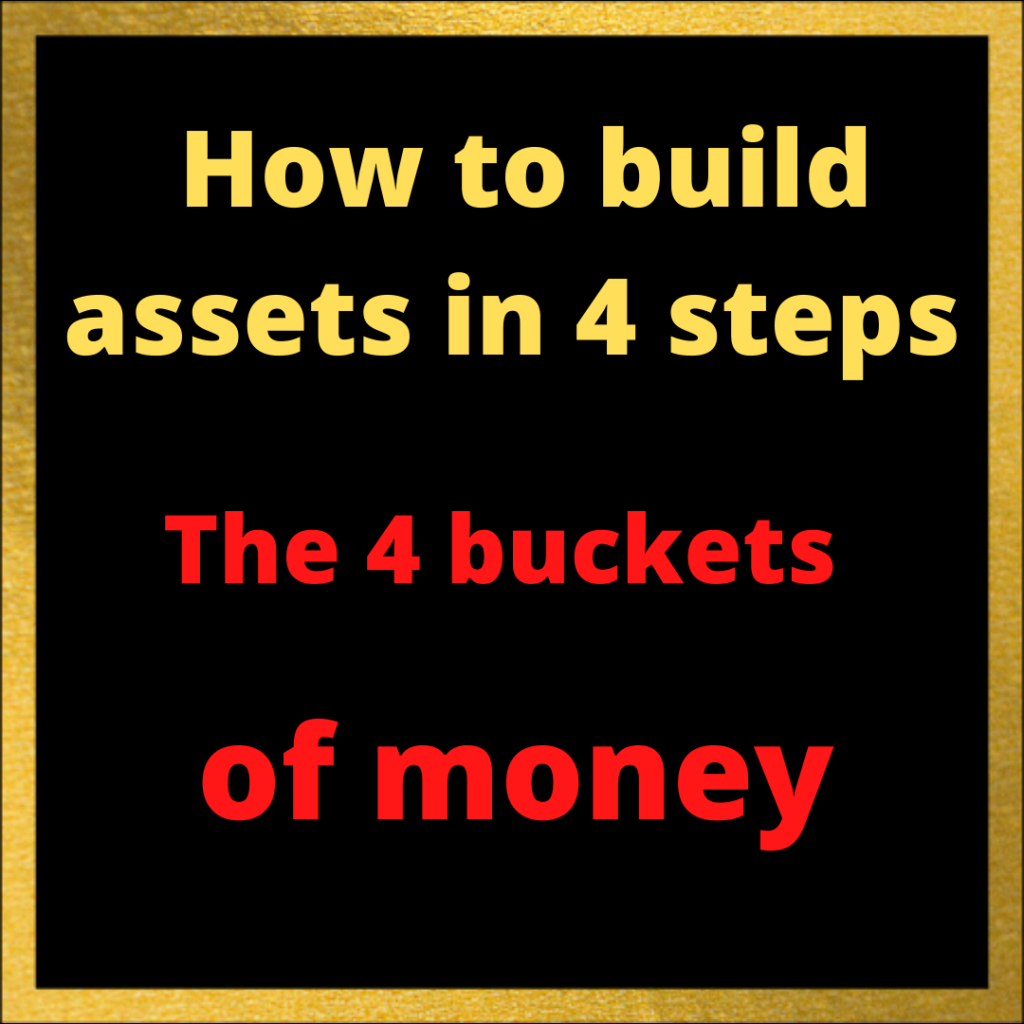
So you want to know How to build assets in 4 steps.
Wow I am so glad to be back. If you recall or remember you may know that I am in the accounting profession and have thankfully finished my 33rd tax season. Year in and year out I see how people make money and how they lose it. I should absolutely disclose that you should bring your questions to a competent professional before making any decisions just based on this blog. Please be aware that I have included certain business links on which a commission is earned. These commissions help support my continuing ability to write this blog
I do not know if you would be interested, but I can tell you some common traits that I see year and year out.
People who are money savy always know how and where they are spending their money. In fact, they always have a way to raise cash should an interesting opportunity pass their way.
Interested?
Well let’s get on with it.
The four buckets of money
Bucket # 1
The Taxable income bucket.
Sometimes I think this bucket is the worst of all, because for the most part it is not only the highest taxed bucket, but it is always the bucket with the least amount of leverage.
Leverage you say? What’s that?
In this case it is trading time for money. You work a certain amount of hours, and they pay you a certain amount of money. The leverage here is 1:1. You expend work and get paid hourly, weekly or monthly. The only issue here is that there is only so much of you to go around, and unless you are in the entertainment business like sports or entertainment you will rarely get paid a disproportionate amount of money for the work you put in.
Other items in the taxable bucket, are interest, dividends, and commissions.
Interest and dividends are certainly attractive, because they are passive. Unfortunately, they take such large sum of money to receive any kind of liveable income.
Let me give you an example, let’s say you had $100,000 to invest, and could actually get 5%. You would receive $5000 a year in income in gross. Unfortunately, once Uncle Sam and his partner the state government take their pieces you would probably only be left with mere $3750 net of taxes. This lowers your nominal after tax return to a mere 3.75%
If you are savy you have put some tax money aside to cover the taxes so that you do not have to interrupt the compounding of the interest. In other words, would you like your interest to be compounded on $105,000 or $103,750. I am guessing you picked the bigger number. Most would.
Year 2 you would receive $5250 in compound interest vs $ 3937.50. The other issue here is if you choose not pay taxes from your investment, your tax bill will be increasing each year and lowering the amount of money that you have to pay living expenses.
Double bummer.
What do I do? Hey, the government had a great idea: the tax postponed bucket.
Bucket #2
The tax postponed bucket
What is that you ask?
Ever heard of an IRA, 401k, 403b, or a 457 plan. These are all tax postponed buckets. You may have also hear of them as compensation deferral or deferred comp plans. They are not tax free, but tax deferred.
Wow Scott that sounds great.
Reduce my taxes today, and pay taxes later on. The part of what the government does not really tell you is that one day you will taxed on your deferrals plus any earnings you have accumulated. So lets say your deferral plus earnings is $100,000. Let’s forward to Age 72 when they force you to take your deferrals, they tax you on the whole lump sum or pieces of it that you take out over time. By the way, if you do not take your required minimum distributions, the government charges you a penalty of 50% if you do not take out what you were required to do.
Before you boil over and say Scott there must be a better way, let’s explore tax bucket #3 the partial tax bucket.
Bucket #3
The Partial tax bucket
Hey I am liking the sound of this already, sign me up Scotty.
Generally the partial tax bucket has to do with rental real estate. MACRS the modified cash recovery system (depreciation) can sometimes make rental properties tax cash flow negative while producing positive economic cash flow. A good attribute when considering taxability of your rents.
The tough thing with rental real estate is the leverage that it requires. Leverage here is another name for debt. You have to use your rents to pay that debt, and if the space is not rented you still have to pay your debt.
That brings us to bucket #4. The tax free bucket.
Bucket #4
The tax free bucket.
There are a couple of ways to create the tax free bucket. One by creating a Roth account which can create tax free distributions from your original contributions and your earnings if and only if you are over 59 1/2 years of age.
The second way to create tax free cash is policy loans from a life insurance contract.
Can I hear the groans here?
I know you thought life insurance only works if you die. Not true. In fact it is the source of money I used to pay for my son’s college.
Interesting?
Review the 4 buckets
Each of us have some of the buckets in our life but not all of them.
What are you missing?
If you have any questions feel free to contact Scott at his email. Scott@scottrulon.com
Additional Blogs & Links
Intelligence Prime Capital Review
Step by step instructions to build an online business
